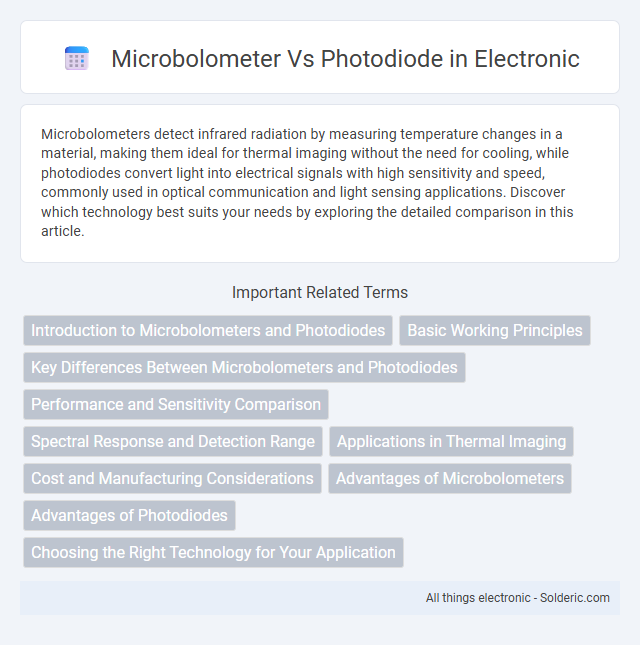Microbolometers detect infrared radiation by measuring temperature changes in a material, making them ideal for thermal imaging without the need for cooling, while photodiodes convert light into electrical signals with high sensitivity and speed, commonly used in optical communication and light sensing applications. Discover which technology best suits your needs by exploring the detailed comparison in this article.
Comparison Table
| Feature | Microbolometer | Photodiode |
|---|---|---|
| Detection Type | Thermal infrared radiation | Photon detection (visible to infrared light) |
| Sensitivity | Moderate, sensitive to temperature changes | High, sensitive to light intensity |
| Cooling Requirement | Uncooled sensor | Usually cooled or uncooled depending on application |
| Response Time | Slower, on the order of milliseconds | Fast, nanoseconds to microseconds |
| Wavelength Range | Long-wave infrared (8-14 um) | Visible to short-wave infrared (0.4-3 um) |
| Applications | Thermal imaging, night vision, temperature measurement | Optical communication, lidar, spectroscopy |
| Cost | Generally lower cost, mass-produced for infrared cameras | Varies widely; can be high cost for cooled photodiodes |
Introduction to Microbolometers and Photodiodes
Microbolometers are uncooled infrared detectors that measure temperature by detecting changes in resistance caused by absorbed thermal radiation, making them ideal for thermal imaging applications. Photodiodes are semiconductor devices that convert light into electrical current, commonly used in visible and near-infrared light detection for optical communication and sensing. Both technologies serve distinct purposes in imaging and sensing, with microbolometers excelling in detecting long-wavelength infrared radiation and photodiodes offering high sensitivity and fast response in specific light spectra.
Basic Working Principles
Microbolometers detect infrared radiation by measuring temperature changes in a material with variable resistance when exposed to IR energy, enabling thermal imaging without cooling. Photodiodes operate by converting incident light photons into an electric current through the photoelectric effect, providing rapid and sensitive detection in specific wavelengths. While microbolometers rely on thermal response, photodiodes depend on direct photon-to-electron conversion for their sensing mechanism.
Key Differences Between Microbolometers and Photodiodes
Microbolometers detect infrared radiation through temperature changes in a material that alters its electrical resistance, making them ideal for thermal imaging without cooling requirements. Photodiodes generate current when exposed to light or infrared photons, offering faster response times and higher sensitivity in specific wavelength ranges but typically requiring cooling for infrared applications. Your choice depends on whether you prioritize uncooled operation and thermal sensitivity (microbolometer) or faster detection and spectral selectivity (photodiode).
Performance and Sensitivity Comparison
Microbolometers excel in detecting long-wave infrared radiation with high sensitivity to temperature variations, making them ideal for thermal imaging applications, while photodiodes offer faster response times and better performance in visible to near-infrared wavelengths. Photodiodes provide higher signal-to-noise ratios and greater sensitivity in low-light environments, but microbolometers operate effectively without cooling, enhancing reliability and reducing system complexity. Your choice depends on the specific sensitivity requirements and spectral range of your application, balancing response speed against thermal detection capabilities.
Spectral Response and Detection Range
Microbolometers operate primarily in the long-wave infrared (LWIR) spectrum, typically between 7 to 14 micrometers, making them ideal for thermal imaging and detecting temperature variations. Photodiodes have a broader spectral response, covering ultraviolet to near-infrared wavelengths, generally from 200 nanometers to 1100 nanometers, which suits applications like optical communication and light sensing. Your choice depends on the required detection range and spectral sensitivity, with microbolometers excelling in thermal detection and photodiodes in visible to near-infrared light detection.
Applications in Thermal Imaging
Microbolometers are widely used in thermal imaging applications such as firefighting, surveillance, and industrial inspection due to their sensitivity to long-wavelength infrared radiation and ability to operate uncooled at room temperature. Photodiodes, particularly those based on InGaAs or HgCdTe materials, are preferred in applications requiring high-speed response and higher sensitivity in short-wave to mid-wave infrared imaging, including missile guidance and scientific research. Your choice between microbolometer and photodiode detectors depends on the specific thermal imaging requirements like spectral range, sensitivity, and operational environment.
Cost and Manufacturing Considerations
Microbolometers generally offer lower production costs due to simpler manufacturing processes and reliance on uncooled infrared detection, making them ideal for affordable thermal imaging applications. Photodiodes require more complex semiconductor fabrication and cooling mechanisms, increasing overall costs but providing higher sensitivity and faster response times. Your choice depends on balancing budget constraints with performance needs, where microbolometers excel in cost efficiency and photodiodes in precision.
Advantages of Microbolometers
Microbolometers offer significant advantages over photodiodes, including higher sensitivity to long-wave infrared radiation and the ability to operate without cooling systems, resulting in reduced size, weight, and power consumption. These uncooled sensors provide enhanced reliability and lower maintenance costs, making them ideal for portable thermal imaging devices and continuous monitoring applications. Your choice of microbolometer technology ensures efficient performance in detecting thermal radiation in various environmental conditions.
Advantages of Photodiodes
Photodiodes offer superior sensitivity and faster response times compared to microbolometers, making them ideal for applications requiring rapid detection of light signals. Their ability to operate effectively in low-light conditions enhances accuracy and reliability in optical sensing and communication systems. You benefit from photodiodes' lower noise levels and higher dynamic range, ensuring precise measurements in diverse environments.
Choosing the Right Technology for Your Application
Microbolometers excel in uncooled infrared detection with high sensitivity and low power consumption, ideal for thermal imaging in security and industrial monitoring. Photodiodes offer faster response times and higher accuracy under controlled lighting, making them suitable for optical communication and precision sensing. Selecting between microbolometer and photodiode technologies depends on application-specific requirements such as operating environment, sensitivity needs, and speed of detection.
Microbolometer vs Photodiode Infographic

 solderic.com
solderic.com